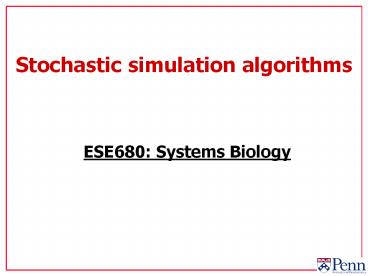Stochastic simulation algorithms - PowerPoint PPT Presentation
Title:
Stochastic simulation algorithms
Description:
Stalled ribosomes. ppGpp synthesis. Reprogramming of transcription ... R = ribosome activity. Transcription: Reaction kinetics. Translation: Reaction kinetics ... – PowerPoint PPT presentation
Number of Views:105
Avg rating:3.0/5.0
Title: Stochastic simulation algorithms
1
Stochastic simulation algorithms
- ESE680 Systems Biology
2
Relevant talks/seminars this week!
- Prof. Mustafa Khammash (UCSB)
- Noise in Gene Regulatory Networks Biological
Role and Mathematical Analysis - Friday 23 Mar, 12-1pm, Berger Auditorium
- Dr. Daniel Gillespie (Dan Gillespie Consultant)
- Stochastic Chemical Kinetics
- Friday 23 Mar, 2-3pm, Berger Auditorium
3
Chemical reactions are random events
B
B
A
A
4
Poisson process
- Poisson process is used to model the occurrences
of random events. - Interarrival times are independent random
variables, with exponential distribution. - Memoryless property.
event
event
event
time
5
Stochastic reaction kinetics
- Quantities are measured as molecules instead of
concentration. - Reaction rates are seen as rates of Poisson
processes.
k
A B ? AB
Rate of Poisson process
6
Stochastic reaction kinetics
A
AB
time
reaction
reaction
reaction
time
7
Multiple reactions
- Multiple reactions are seen as concurrent Poisson
processes. - Gillespie simulation algorithm determine which
reaction happens first.
A B ? AB
Rate 1
Rate 2
8
Multiple reactions
A
AB
time
reaction 1
reaction 2
reaction 1
time
9
t leaping scheme
A
AB
time
r2
r1
r2
r1
r1
r2
r1
D
D
D
D
time
10
Erlang distribution
11
Erlang ? Gaussian
12
Stochastic simulation with Gaussian rv
13
Stochastic simulation with Gaussian rv
Ito stochastic integral
14
Chemical Langevin equation
White noise driving the original system
15
Stochastic fluctuations triggered persistence in
bacteria
- ESE680 Systems Biology
16
(No Transcript)
17
Bacterial persistence
- Discovered as soon as antibiotics were used
(Bigger, 1944) - A fraction of an isogenic population survives
antibiotic treatment significantly better than
the rest
- If cultured, the surviving fraction gives rise to
a population identical to the original one - Bimodal kill curves
- Persisters are a very small fraction of the
initial population (10-5-10-6)
(from Balaban et al, Science, 2003)
18
Persistence as an evolutionary advantage
- Persisters are an alternative phenotype
- Similar to dormancy or stasis
- Since they do not grow, they are less vulnerable
- Presence of multiple phenotypes has an
evolutionary advantage in survival in varying
environments - Transitions between phenotypes are of stochastic
nature - Random events, triggered by noise
- What is the underlying molecular mechanism?
19
Persistence as a phenotypic switch
- Recent work due to Balaban et al showed that
there are two types of persisters - Type I generated by an external triggering
event such as passage through stationary phase - Type II generated spontaneously from cells
exhibiting normal phenotype
20
(No Transcript)
21
Stringent response and growth control
- Triggered by adverse conditions, e.g. starvation
- Transcription control (p)ppGpp
- Lack of nutrients
- Stalled ribosomes
- ppGpp synthesis
- Reprogramming of transcription
- Translation shutdown
- Proteases
- (p)ppGpp involved
- Activation of toxin-antitoxin modules
- Toxin reversibly disables ribosomes
ppGpp
Lon
Toxins
RAC
TRANSLATION
TRANSCRIPTION
GROWTH
NUTRIENT AVAILABILITY
22
Tox
Ant
Ribosome
Ribosome
Ribosome
23
Toxin-antitoxin modules
- Toxin and antitoxin are part of an operon
- Overexpression of toxin leads to stasis
- Toxin cleaves mRNA at the stop codon
- Cleaved mRNA disables translating ribosomes
- Ribosomes can be rescued by tmRNA
- One example RelB and RelE
- (Gerdes 2003)
24
Toxin-antitoxin modules
- TA module provides an emergency brake
- Normally all toxin is bound to antitoxin
- Antitoxin binds toxin at a ratio gt 1
- Antitoxin has a shorter half-life
- Shutdown can be triggered by fluctuations
- Toxin excess ? reduced translation ? more excess
toxin ?..? translation shutdown - Recovery from shutdown facilitated by tmRNA which
reverses
25
Reaction kinetics
- Variables
- T Toxin concentration
- A Antitoxin concentration
- R ribosome activity
- Transcription
26
Reaction kinetics
- Translation
27
Reaction kinetics
- Ribosome dynamics
28
Deterministic simulation result
Toxin
Antitoxin
Ribosome activity
29
Stochastic simulation result
Toxin
Antitoxin
Ribosome activity

